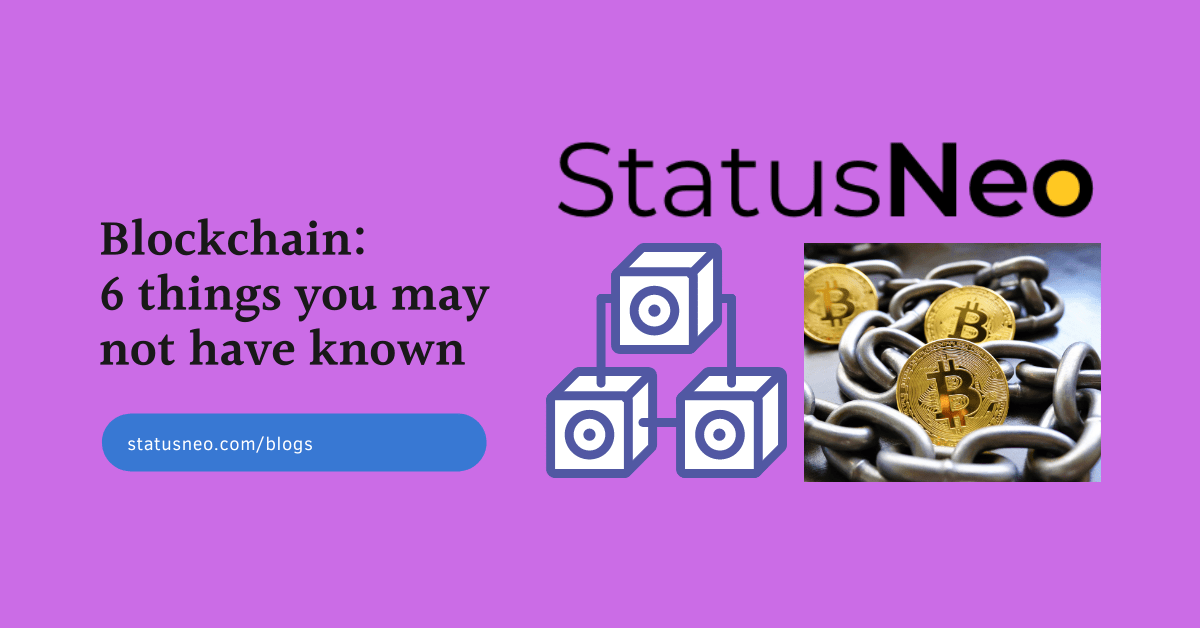Blockchain: 6 things you may not have known
6 Things to Know about Blockchain
A cryptocurrency called Bitcoin is the best-known and one for which blockchain technology was invented. In contrast to the US dollar, a cryptocurrency uses encryption techniques to control the creation of monetary units and to verify the transfer of funds. Due to its nature, this is more robust and secure than the proprietary, centralized models presently used in the trade ecosystem.
1. Bitcoin and blockchain are two segregated things
Blockchain is the underlying technology of bitcoin, but they are not the same. Although they are closely related, they are not the same.
Bitcoin was an unregulated digital currency created in 2008 by the pseudonymous Satoshi Nakamoto. Blockchain was considered as a solution that was used to securely record transactions. There was no bank or government to monitor its use. Bitcoin can be considered the first use case for blockchain technology since it was introduced at the same time as blockchain. This often leads to confusion between the two concepts.

2. The blockchain is a unified system
A blockchain solution will likely have the same common denominators as blockchain technology, such as having a distributed ledger technology underpinned by cryptography and requiring a consensus mechanism.
Today, there are dozens of different protocols that are considered blockchains and can be classified as distributed ledger technologies. For example, Ethereum, Corda from R3, Fabric from IBM are some examples.
While some solutions are similar to one another, others differ a great deal.
3. Everyone has access to private information on the blockchain
Since the distributed ledger is public, many people believe that all of their information and transaction details posted on the blockchain are public. This is not true. While visibility varies with application use and technology, the answer to this question is that all business-to-business transactions are private and only accessible with the appropriate permissions.
Companies that use blockchains to distribute data to suppliers don’t mean their competitors can see the suppliers or what they’re buying. And suppliers can’t see the data of other suppliers. It’s all private and secure, and suppliers only see the data the buyer can see.
A distributed ledger does not contain any transactional information other than the transaction amount and the hash. The hash is a numerical code generated by running the transactional details through a cryptographic process. Therefore, it is impossible to get more information on the transaction.

4. Contracts with smart features are legal documents
Smart Contracts are neither “smart” nor “contracts” as typically construed as legal documents. Smart Contracts were first introduced by cryptography researcher Nick Szabo in the year 1994, which consists of software code written by developers.
A Smart Contract is a set of instructions that are triggered by an event. For example, if goods arrive at a customer’s warehouse by this date, release the payment to the supplier. Therefore, by automatically updating shipments and receipts, Smart Contracts can automate many processes. It eliminates the need to manage time-consuming and costly manual business processes.
A smart contract is a digital program that automates the execution of business logic and obligations. It can represent almost anything – a warehouse receipt, a bond, an invoice, a unit of electricity, a unit of currency, a futures contract, a share of risk, and more.
These assets that are distinct within themselves by cryptography can be created, sold, and settled. It is possible to write a smart contract that incorporates almost any type of business logic that can be enforced automatically under the terms and conditions of the agreement.

5. Blockchain data is publicly accessible
Some public blockchains are open, while others are private and only accessible to specific users.
The use case will determine which type of blockchain is required. There are basically three types of blockchains.
- Public blockchains:
An individual can participate in a public blockchain by downloading the required software on their device. This allows them to store, send, and receive data on the blockchain. Anyone can read or write the data stored on the blockchain since it is publicly accessible.
There is no central authority in public blockchains, thus all users have equal access to read and write data. Before any data is stored, a consensus is reached by all users, and the data is stored on the chain.
Bitcoin is the most popular example of a public blockchain. It is a digital currency that enables users to make direct transactions with each other.
- Private blockchains:
Private blockchains are typically used within an organization with a few specific users having access to it and being able to execute transactions.
According to their established rules and regulations, the organization in control can change the rules of the private blockchain and also decline transactions.
Blockchain technology can be used, for example, to collaborate with other divisions of a corporation or a few people with permission.
- Consortium blockchains:
Consortium blockchains, also called permission blockchains, can be thought of as a hybrid model between public blockchains with their low level of trust and private blockchains with their single highly-trusted entity model.
Unlike a public blockchain that allows any user to participate in transaction verification or a company that only controls a specific piece of the process, a consortium blockchain allows only a very limited number of users to participate.
Let us consider, for example, ten banks connected to the blockchain network. In this case, seven out of ten banks would have to agree for the block to be valid.

6. Nothing more than a buzzword, blockchain
A blockchain is a real technology available today. Currently, blockchain is being tested in many industries and regions around the world through Proof of Concepts (POCs). Also, remember that this is still very early days for blockchain.
The first versions of several blockchain solutions, including those from IBM and R3, were released in 2017. So, this is all very new and just emerging.
Blockchain is undoubtedly an overused term that has been covered in multiple media outlets daily. This does not equate to only being a buzzword, as evidenced by the investment numbers. Over $280 million was spent on blockchain technology by capital markets firms1 in 2016, with 90% of North American and European banks exploring the technology.
In the same year, over $1.4 billion was invested in blockchain startups. As of right now, a third of leading banks are partnering with a technology company to enhance their blockchain capabilities. With the adoption and implementation of blockchain technology, Accenture expects to save more than $8 billion annually for the largest eight banks.
The implementation of blockchain technology can result in 70% cost savings on business operations, as well as 30%-50% savings on compliance.
Conclusion:
In all its features and applications, blockchain technology isn’t just another fad that can be forgotten after a week or two. It seems safe to assume that it’s here to stay. The blockchain’s features are having a very significant impact on the web.
The gadget is filled with all kinds of new technology, so why wouldn’t it? Despite the controversy surrounding blockchain, if people can utilize the concept behind its all-inclusive benefits, then we can have a better, brighter world. Aside from that, blockchain is set to revolutionize our world.
Add Comment
You must be logged in to post a comment.







